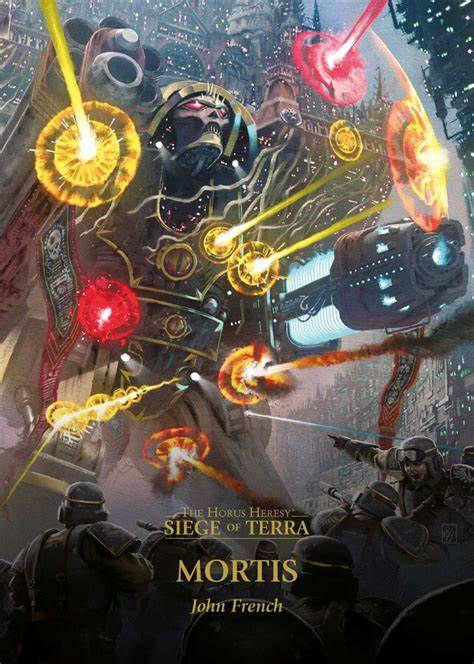Mortis
- Spartan Stoic

- Jan 3, 2023
- 3 min read
By John French
This is book five in the Horus Heresy Siege of Terra series, set in the Warhammer 40,000 Universe (but during the Horus Heresy, 10,000 years earlier).
The walls are coming under their final pressure. We’ve seen Horus get closer and closer as he tightens his grip and now he sends the titans of Legio Mortis to finish the job. This book, then, progresses the pressure on the walls as the traitors try to break through.
From cradle to grave
The story of this one continues the action of breaking down Terra’s walls. Whilst doing that, it revisits many characters we’ve been following, from Primarch to guardsman: Katsuhiro, Amon Tauromachian, Rogal Dorn, John Grammaticus and more. The book also includes – unlike the other Siege of Terra books – a focus on the titan legions. The Legio Mortis battles the Legio Ignatum with often explosive results.
The story jumps around a lot from scene-to-scene, and I often find John French either absolutely brilliant but sometimes exasperating, as the jumps from different scenes aren’t always signposted as well as I’d like.
This is also to speak of a design choice for the Siege of Terra series, with narratives spread across the books, the pacing feels driven by the requirement to cram in particular characters which acts like a detriment. I think if the writers had given leeway to focus on particular characters and scenes more the results would feel more fleshed out. I often found myself wishing more time was spent on a particular scene or events. Due to this, the development of characters often doesn’t have time to get anywhere. Although some characters, we know and love (or hate) – such as John and Oll, or Rogal Dorn, were fine and what we know from previous books, some felt like a missed opportunity; such as Shiban Khan or Basilio Fo. They weren’t explored extensively enough or in any sufficient depth to hold meaning. Indeed, their relationships with Cole in the case of Shiban, or the loyalists in the case of Fo, could have been really interesting but never go anywhere deeper than the shallows.

At the walls
The setting is the one we’ve seen over the last few books, and focuses especially on the Mercury Wall which the Legio Ignatum valiantly fight to hold, but you don’t always get a good sense of the flow of the battle. There wasn’t much clarity within the macro descriptions: if the Titans beat those in front of them, what would happen? Are there titans attacking to the flank? It did not provide much of a sense of the sway and flow of the battle; instead focussing on micro events. The action usually felt a bit routine rather than an escalating and gigantic siege.
The imagery by John French often stands out though, and it’s no different here. Fulgrim’s ‘garden’, with tones of John Milton’s paradise lost (which, I should note, was also alluded to in the novella fury of magnus); or the dream visions of Oll and philosophical discussion of cause and consequence were strong moments. The book wasn’t always effective with these references
though: the allusions to mythology with Oll felt ‘tacked on’ and unnecessary. Often, French’s writing tries to be too abstract and clever. Sometimes it throws you into a scene, trying to create mystery, suspense and awe, but you’re busy trying to figure out who/when/what is going on that you don’t feel any of those emotions. Reference points and clarity are still needed to bring out these kind of emotions, and it’s not accomplished by rapidly jumping to different characters and scenes. The shame is that his imagery clearly has massive capability to do it if the pacing was better, this would provide time to delve deeper into these scenes and characters.
Readability
By this stage, the books are heavily reliant on prior characters and events. There’s a lot of references that one wouldn’t be familiar with if coming in fresh; blackstone, the selenar, pariahs for example.
Final score
My overriding issue is I feel Mortis tries a bit too hard to be clever. Rather than getting the fundamentals of building tension and action up, it moves on to other scenes or characters before the groundworks laid well. The pacing of the story feels flawed, but there are some twists and turns, which, although some didn’t feel completely effective, do help to make it a readable book. Along with John’s brilliant imagery, it does save the book from being average, but it probably just slips away from being an average score. Not his strongest work, but readable.
6/10



